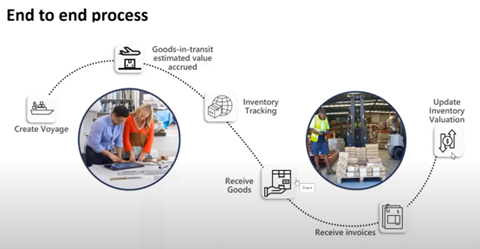This article is the first in a series that will seek to educate readers to make the best decisions for the business with Landed Cost configurations. The Landed Cost module in Dynamics 365 Finance and Supply Chain allows businesses more visibility of their international imports. It enables organizations to track and apply costs associated with those shipments at a more granular level. The module adds new terminology to differentiate between existing Transportation management (TMS) functionality and adds new functionality to help businesses streamline their processes to allow for a more effective cost and logistic analysis. The most notable difference between the modules is that Landed cost is only used for inbound shipments, whereas TMS can be utilized for both inbound and outbound shipments. Table 1 below shows some of the new Landed Cost terms and their TMS equivalents:
Transportation Management vs. Landed Cost

Table 1: Landed Cost and TMS terminology
Landed cost process flow

Image 1: Configurations and Business Process Flow
Landed Cost adds new costing functionality, which allows organizations to compare cost estimates and actual costs by accruing estimated costs and then updating product costs when actual costs are known. This will enable businesses to update product costs based on the aggregate of invoices posted against the product. While this functionality mimics some parts of standard Dynamics 365 auto charges, it also adds new ways to allocate costs by cost type codes. This functionality and other costing processes will be further explained in a future article in the Landed Cost series.
The Landed Cost goods in transit functionality allow organizations to take financial ownership of their goods before they are physically received in a warehouse. Additionally, using goods in transit also enables advanced warehousing for receiving. However, receiving products without advanced warehousing within the landed cost module is still possible using arrival journals. A future article will cover both goods in transit and more standard methods of receiving within the Landed Cost module.
Please contact us here if you have any questions or visit our website to learn more.

 RSMUS.com
RSMUS.com